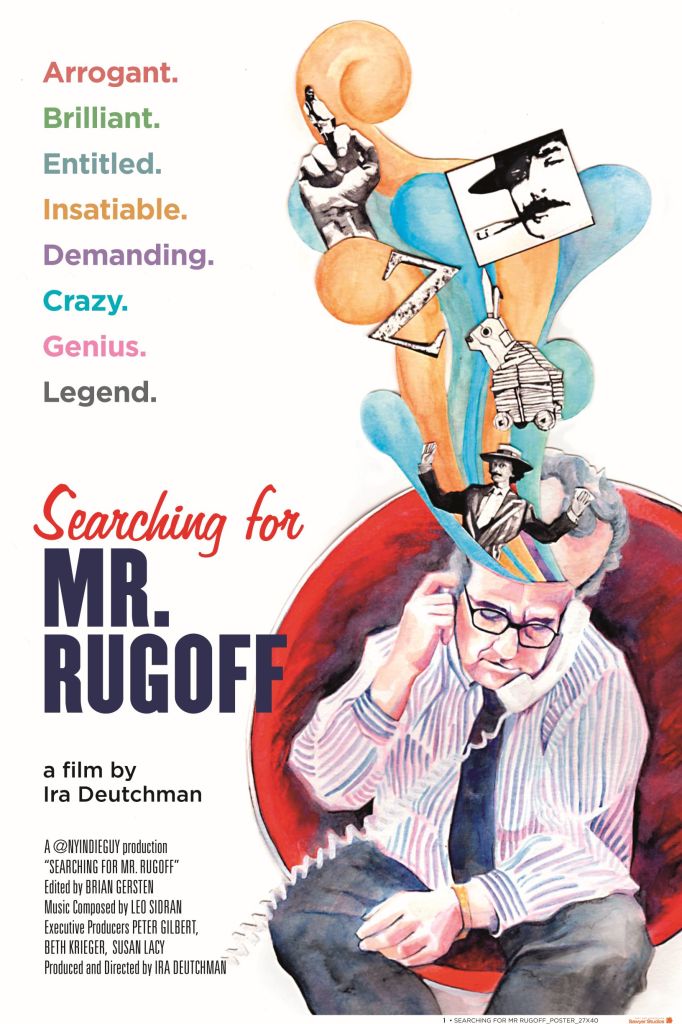By Richard Ades
For people who became film aficionados during the 1960s and ’70s, Searching for Mr. Rugoff is a revelation. Such folks doubtless were intrigued by international filmmakers such as Costa-Gavras, Francois Truffaut, Lina Wertmuller and others, and the documentary reveals that their work might never have made it across the Atlantic if it weren’t for a New York theater owner and distributor named Donald Rugoff.
Full disclosure: I’m one of the many folks who owe my love of films to Rugoff.
Without him, I might never have held my breath over Costa-Gavras’s political thriller Z or laughed at the French spy spoof The Tall Blond Man With One Black Shoe. I also might never have experienced the brilliant but polarizing films of Wertmuller or the head-scratching puzzle that was The Man Who Fell to Earth. Rugoff and his distribution company, Cinema 5, brought these and other notable flicks to the attention of American filmgoers, yet few people remember him.

Director and one-time Cinema 5 employee Ira Deutchman seeks to remedy that situation by talking to people who worked with Rugoff or otherwise knew him. The portrait he paints is of an eccentric man who wasn’t always easy to be around but who seemed to have an innate talent for finding and promoting important cinema.
After inheriting a theater chain following his father’s premature death, Rugoff began opening elegant Upper East Side theaters—“temples of the art,” one commentator calls them—that made going to the movies an indispensable cultural event. People looked forward to major premieres so much that they didn’t even mind standing in the inevitable line to get in. In fact, they savored it as just another part of the ritual.
Rugoff also became a distributor and began championing a host of notable filmmakers, some of whom are interviewed by Deutchman. Costa-Gavras talks about the role Rugoff played not only in bringing his masterful Z to America but in helping it to win two Academy Awards and three additional nominations, including for Best Picture. Wertmuller likewise talks about her experiences with the impresario, who may have helped her to garner the first Oscar nomination ever received by a woman director (for 1975’s Seven Beauties).
We learn that Rugoff had both box office triumphs, such as 1975’s Monty Python and the Holy Grail, and flops, such as Truffaut’s The Soft Skin (1964). But whether the films were hits or misses, he always promoted them with ad campaigns that were groundbreaking and innovative. They were also sometimes controversial, as when he falsely labeled 1977’s Jabberwocky a Monty Python film because its director and star were members of the British comedy troupe.
Rugoff’s success eventually faded, though the documentary can only suggest possible reasons. Was it health problems that impaired his judgment, or possibly a second wife who pushed her own questionable taste in films? Or maybe it was a change in the cinematic climate, along with the rise of competitors inspired by his example. Chances are it was a combination of causes.
At any rate, Rugoff ultimately was forced to exit the business. In 1986, he left New York and moved to a small town on Martha’s Vineyard, where he converted a former church into a movie theater before dying three years later. But even there, Deutchman learns, he’s been largely forgotten.
Someone who played such a crucial role in our country’s cinematic scene really deserves to be honored and remembered. With the release of Searching for Mr. Rugoff, maybe he will be.
Rating: 4 stars (out of 5)
Searching for Mr. Rugoff opened Aug. 13 at select theaters and through VOD outlets.
